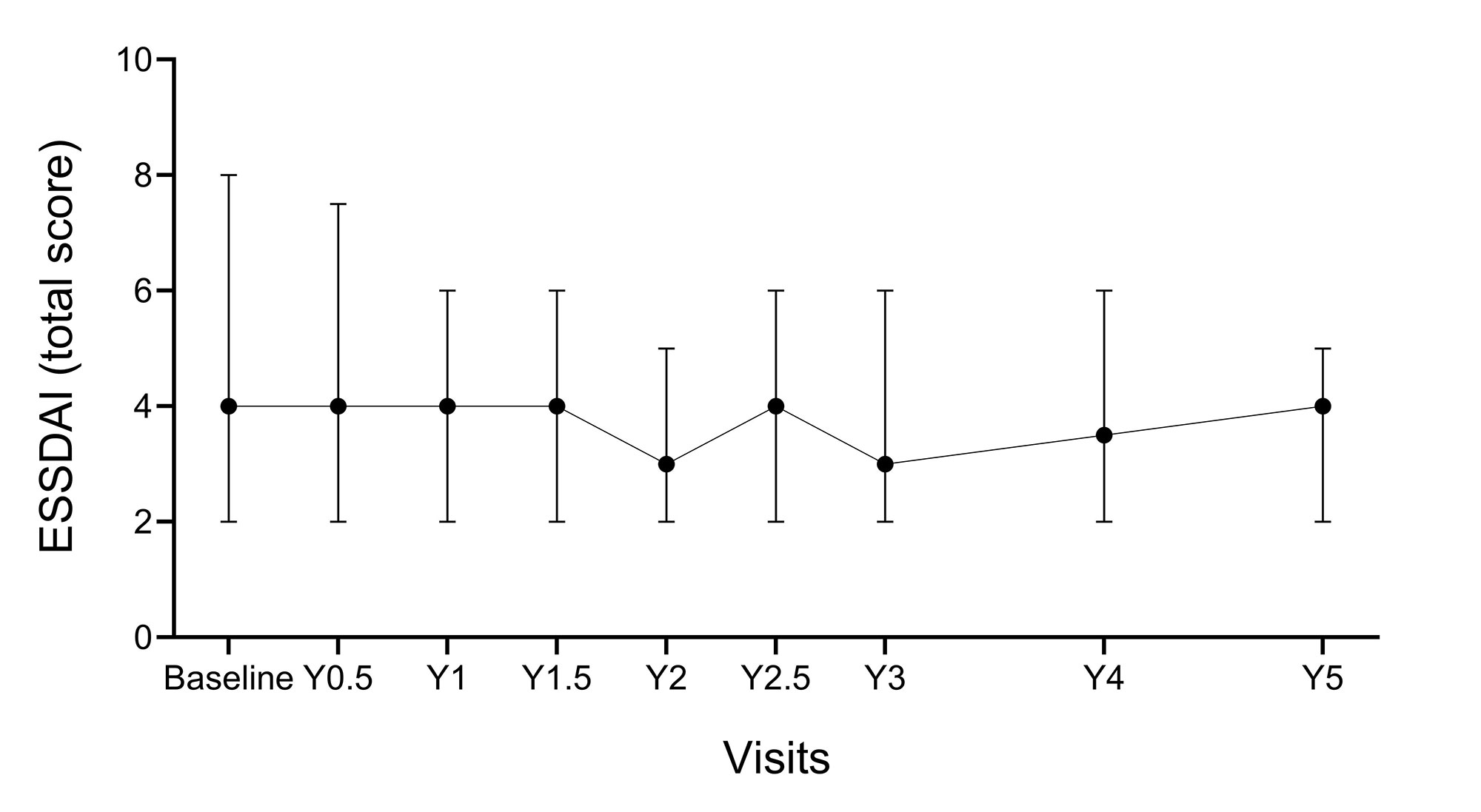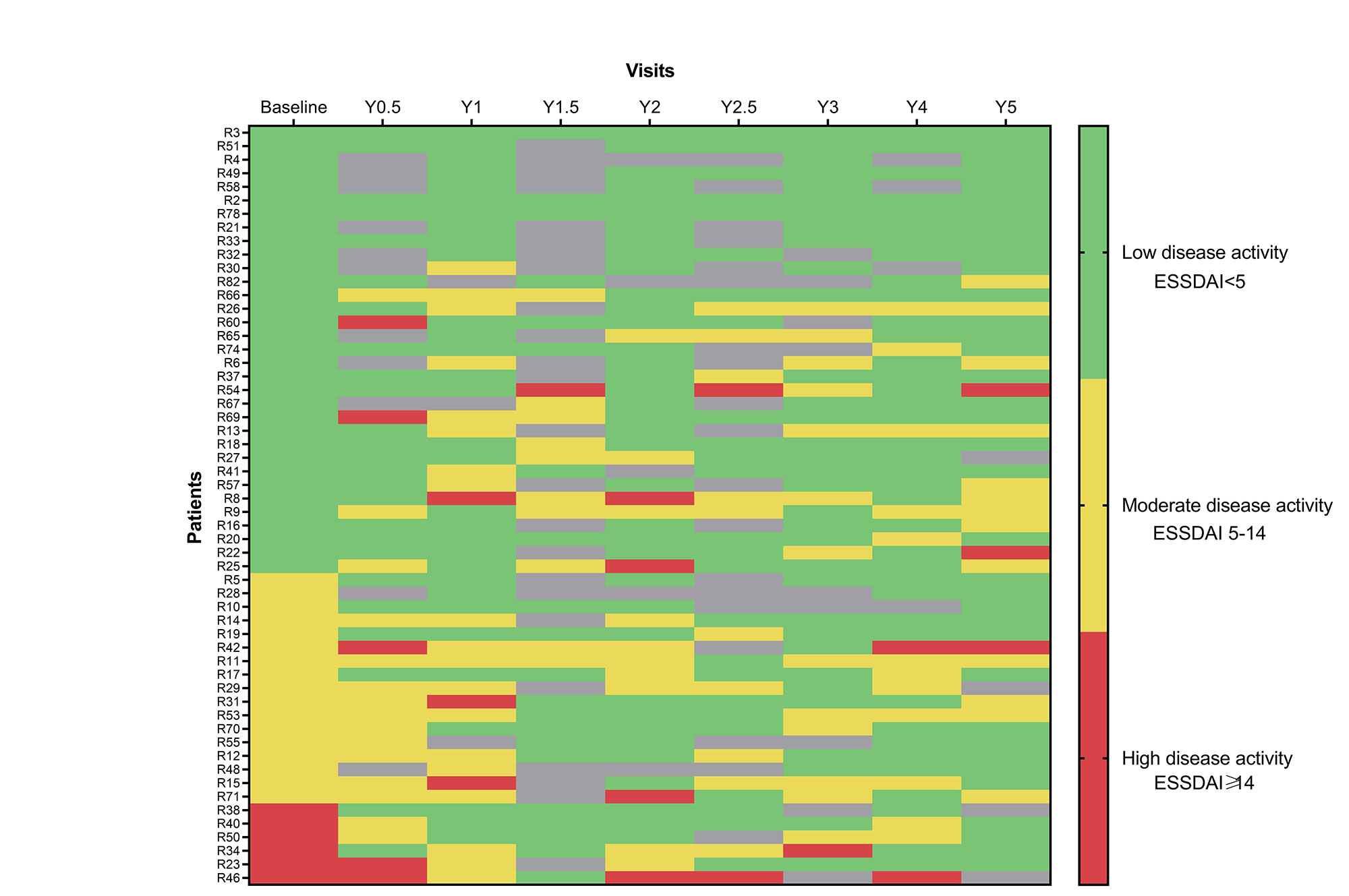Session Information
Session Type: Poster Session D
Session Time: 1:00PM-3:00PM
Background/Purpose: The EULAR Sjögren’s Syndrome Disease Activity Index (ESSDAI) is often used as primary endpoint in randomised clinical trials (RCTs) in patients with primary Sjögren’s syndrome (pSS). Recent RCTs which applied ESSDAI moderate or high disease activity (score ≥5) as inclusion criterion showed a large placebo effect with the ESSDAI, which may be due to regression to the mean.1 There is little data available on the natural course of the ESSDAI in daily clinical practice. Therefore, the objective of this study was to evaluate the variation in ESSDAI during five years of follow-up in a standard of care cohort of pSS patients.
Methods: For this prospective longitudinal study, consecutive outpatients with pSS from the Registry of Sjögren Syndrome LongiTudinal (RESULT) cohort who fulfilled ACR/EULAR classification criteria for pSS and who reached five years of follow-up were included. Patients who participated in RCTs during the cohort study were excluded. Patients visited the outpatient clinic once a year or on clinical indication twice a year, and at each visit the ESSDAI was collected. For year 3 (Y3) and Y4, missing ESSDAI data was imputed with the ESSDAI of Y3.5 or Y4.5 if available, respectively. Descriptive statistics were used for baseline characteristics and for evaluation of ESSDAI during the course of the observational cohort study.
Results: Until May 2022, 61 pSS patients reached five years of follow-up in the on-going RESULT cohort. Of these, 56 fulfilled the ACR/EULAR classification criteria and did not participate in an RCT during the cohort study. Of these, 46 (82%) were female, mean age was 52 (SD ± 14) years, median disease duration was 6 (IQR 3-10) years and 53 (95%) were SSA positive. Median ESSDAI at baseline was 4 (IQR 2-8), and 33 (59%) had low disease activity (ESSDAI< 5). At group level, the ESSDAI remained stable during five years of follow-up (Figure 1). At individual patient level, the ESSDAI varied during these five years for the majority of patients (Figure 2). Approximately one fifth of all patients remained constant in a low disease activity, but all other patients had a moderate or high disease activity for at least one visit (Figure 2). Of the patients with a low disease activity at baseline (n=33), approximately one third remained stable. All patients who initially had a moderate or high disease activity at baseline (n=23) improved to a low disease activity for at least one visit (Figure 2).
Conclusion: In this prospective longitudinal standard of care cohort, large individual patient variation in ESSDAI was seen during five years of follow-up, although median ESSDAI scores remained stable at group level. A minority of the patients remained stable with low disease activity according to the ESSDAI. Further analyses of treatment effects will follow.
References
1. De Wolff et al., Clin Exp Rheum 2020.
To cite this abstract in AMA style:
de Wolff L, Arends S, Stel A, van Zuiden G, van Nimwegen J, Vissink A, Kroese F, Verstappen G, Bootsma H. Five Year Follow-up of Systemic Disease Activity Measured with the ESSDAI in a Standard of Care Cohort of Patients with Primary Sjögren’s Syndrome [abstract]. Arthritis Rheumatol. 2022; 74 (suppl 9). https://acrabstracts.org/abstract/five-year-follow-up-of-systemic-disease-activity-measured-with-the-essdai-in-a-standard-of-care-cohort-of-patients-with-primary-sjogrens-syndrome/. Accessed .« Back to ACR Convergence 2022
ACR Meeting Abstracts - https://acrabstracts.org/abstract/five-year-follow-up-of-systemic-disease-activity-measured-with-the-essdai-in-a-standard-of-care-cohort-of-patients-with-primary-sjogrens-syndrome/


